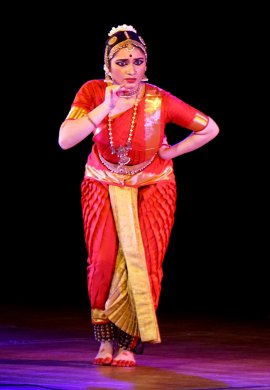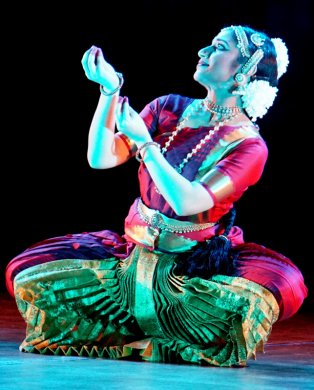 |
       |
 |
       |
|
Meera Sreenarayanan's Harini - Navya Maitri Konda e-mail: navyamkonda@gmail.com Photos: V.V. Hariharan August 24, 2019 Hindus often revere Lakshmi simply as the flawlessly pure goddess, whose kataksham is coveted and craved. In her ode to the Goddess, entitled Harini, Meera Sreenarayanan therefore took an unusual yet wondrous approach, shedding light on Lakshmi beyond just her sublimity. Presented at Natyarangam's 23rd Annual Thematic Bharatanatyam Festival - Devi Bharatam - Harini took this unlikely angle through the eyes of yet another unlikely character, the honeybee, who, despite its key role in the ecosystem, is often despised as a stinging pest. Uniquely personifying the bee and revealing its plea to unite with Mother Lakshmi, the production compelled audience members to develop affection and affinity towards the insect, while being led on an incredible journey of devotion, wonder, and joy. In the midst of its prayer (illustrated by the honey bee kneeling in center spotlight chanting "Sreem, Sreem, Sreem..."), the honeybee explained how it discovered Goddess Lakshmi and continued to grow infatuation and reverence for her brilliance. While these numerous episodes indeed each added more layers to Lakshmi's extraordinary and multifaceted nature, what made the production that much more poignant was the masterful strategy that underlay the juxtaposition between shakti and bhakti, energy and stillness. Indeed, this juxtaposition was revealed through virtually every aspect of Harini. At the outset, the stillness of the milky ocean was contrasted with a dynamic alarippu showcasing Lakshmi as the embodiment of the supreme lotus, while the frantic buzzing of the bee (awe-inspiringly emphasized through the rendering of buzzing-like alapana by Bhagyalakshmi Guruvayur) was immediately quelled when it fixated on the Goddess in utter wonder. Numerous high-energy nritta sequences in full light ended in dynamic poses on the raiser, lit only by the colored light on the back screen, while the festive celebration of Lakshmi's wedding was directly followed by the soul-stirring depiction of her first night through the composition, "Paluku thennela thalli", and then proceeded with her slaying of the demons. The musical score also employed the juxtaposition tactic, with compositions often preceded and punctuated with soulful alapanas and slow verses to add to the effect.   Perhaps the most breathtaking example of the juxtaposition strategy, however, was the way in which Harini concluded. Finally reunited with the Goddess, the jubilant honeybee danced a fast-paced thillana emphasized by large movements and ample stage coverage. At this juncture, the energy in the auditorium was apparent, and the production could have easily ended on this electrifying note (as most productions do). However, then came the awe-inspiring Neelambari, the lilting mangalam, through which the bee sat on center stage and slowly surrendered itself to the Goddess. These Neelambari moments were truly ethereal, invoking a deeply emotional quality that permeated the auditorium. The remarkable, subject-specific choreography was yet another integral piece in augmenting the presentation strategy. For starters, Meera Sreenarayanan's incredible personification of the bee - through which she explored varied emotions the bee felt - added ample color to the storyline. Specifically, while narrating Goddess Lakshmi's marriage day, the bee argued with another bee as to who Lakshmi's husband must be, comically expressing that the man covered in snakes and the elderly, bearded sage mustn't be her picks. As Goddess Lakshmi prepared for her first night, the bee was again bothered by another bee who was full of questions. Moreover, when near the end of the production Goddess Lakshmi invited the bee to sit on her lotus, the bee buzzed around in euphoria and Goddess Lakshmi could not seem to keep up with its frenzied flying. Additionally, the extensive usage of the bramara, mukula, and alapadma mudras combined with the airy nature of the adavus employed caused the nritta sequences to be as poignant parts of Harini as well. Needless to say, while Meera Sreenarayanan's seamless and soul-stirring dancing style makes her an incredible inspiration to countless aspiring dancers (including myself) globally, it was her wonderful vision coupled with her breathtaking abhinaya that made Harini truly unforgettable. Armed with the masterful music composition by Edappilly Ajit Kumar, her magnificent orchestra - Udaysankar Lal on the nattuvangam (who also played manjeera, thus adding incredible life to a conveyed Oriya story), Bhagyalakshmi Guruvayur on the vocals, Kalamandalam Sreerang on the mridangam, Soundararajan on the veena, and Sruthi Sagar on the flute - and lighting technician Nambu Kumar Krishan, together added abundant life to her conceptualization. While it is awe-inspiring to note that Harini was Meera Sreenarayanan's first ever thematic work, it is nevertheless truly one for the books. Navya Maitri Konda is a senior disciple of Deepa Mahadevan (artistic director of Tiruchitrambalam School of Dance in Union City, California). In late June, she graduated with her undergraduate degree from Stanford University. |